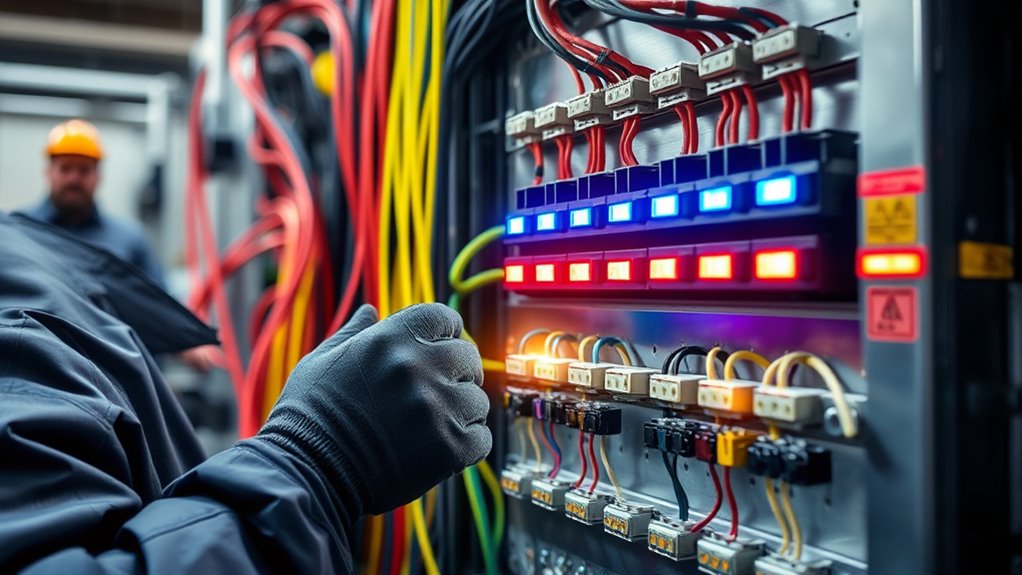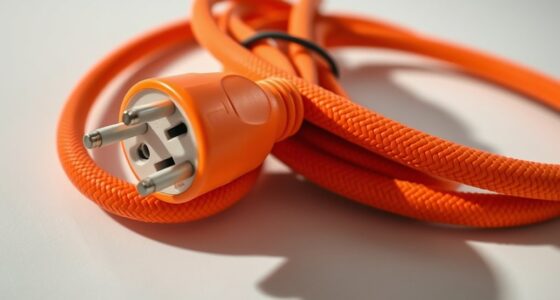Backfeeding occurs when electricity flows from your generator back into utility lines, creating serious safety risks like shocks, fires, and equipment damage. It often happens if you connect a generator incorrectly or bypass safety devices like transfer switches. Signs include flickering lights, warm outlets, or unusual buzzing. To prevent dangers, use proper transfer switches and circuit isolation. Continue exploring how to spot, prevent, and fix backfeeding issues effectively in just 15 minutes.
Key Takeaways
- Properly install transfer switches and circuit isolation to prevent reverse current flow and minimize backfeeding risks.
- Recognize signs like flickering lights, warm outlets, and circuit trips indicating potential backfeeding hazards.
- Avoid connecting generators directly to outlets or utility lines without safeguards; always use dedicated transfer switches.
- Regularly inspect electrical systems for damage, overheating, or unusual sounds to catch hazards early.
- Seek professional help immediately if you notice sparks, burning smells, or persistent electrical issues to ensure safety.
What Is Backfeeding and Why Does It Happen?

Have you ever wondered what causes backfeeding during a power outage? Backfeeding happens when electricity flows from your generator back into the utility lines, which can be dangerous. To guarantee generator safety, it’s essential to use proper circuit isolation measures. When your generator isn’t isolated correctly, power can unintentionally feed into the grid, risking injury to utility workers and damaging equipment. This reverse flow occurs because some appliances or wiring setups connect directly to the main power lines, allowing current to travel backward. Properly isolating circuits with transfer switches or dedicated outlets prevents this. Understanding why backfeeding occurs highlights the importance of following safety protocols. By maintaining circuit isolation, you protect yourself, your neighbors, and utility workers during power outages. Additionally, knowing about spoilage signs of electrical equipment can help prevent potential hazards.
Common Situations Leading to Backfeeding Risks
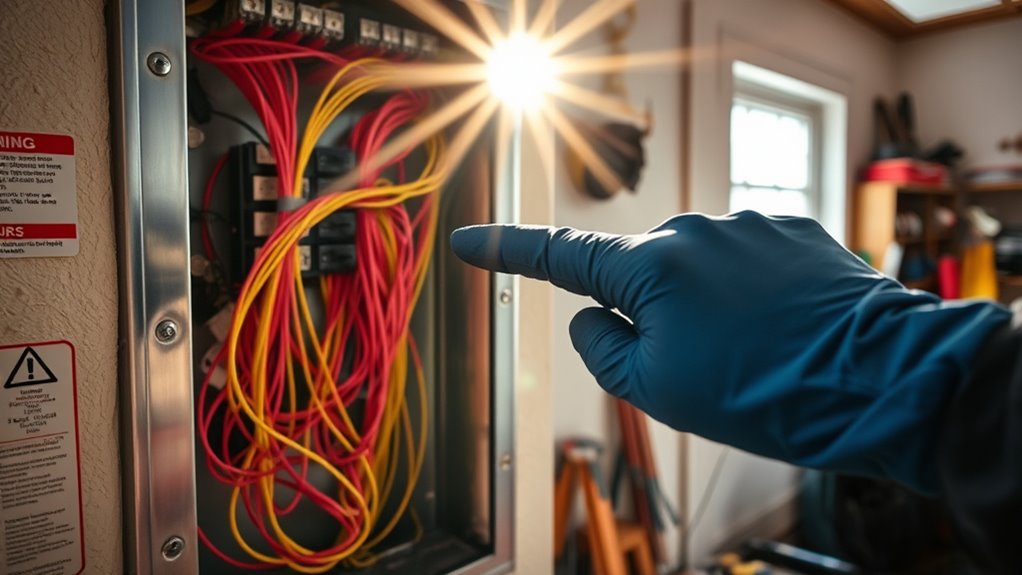
Certain common situations can increase the risk of backfeeding during a power outage. One major factor is improper generator use, which can lead to generator hazards and accidental backfeeding into utility lines. Utility conflicts also occur when homeowners attempt to connect generators directly to the grid without proper transfer switches. This creates dangerous scenarios for utility workers and your neighbors. Additionally, using extension cords improperly or connecting generators to home circuits without safeguards can cause backfeeding. Here’s a quick overview:
| Situation | Risk | Consequence |
|---|---|---|
| Connecting generator directly | Generator hazards, shocks | Power surges, injuries |
| No transfer switch installed | Utility conflicts | Electrocution risks |
| Using extension cords | Uncontrolled backfeed | Equipment damage |
| Overloading generator | Fire hazards | Electrical fires |
| Ignoring safety protocols | Utility conflicts, hazards | Power outages, injuries |
Furthermore, neglecting to properly maintain your generator can increase the risk of malfunctions that lead to backfeeding issues.
Dangers of Backfeeding to People and Equipment

Backfeeding can expose you and your equipment to serious risks. Electrical shocks can occur unexpectedly, putting your safety in jeopardy. Additionally, backfeeding can cause damage to your appliances and electrical systems, leading to costly repairs.
Electrical Shock Hazards
When backfeeding occurs, it creates a serious risk of electrical shock to anyone who comes into contact with the energized equipment or wiring. To prevent this, generator safety measures emphasize the importance of proper circuit isolation. If circuits aren’t isolated correctly, live wires can energize parts of your system unexpectedly, increasing shock hazards. Always verify your generator is disconnected from the main power before backfeeding, and use appropriate transfer switches designed for this purpose. These switches help maintain circuit isolation, preventing power from flowing where it shouldn’t. Remember, contact with energized equipment can cause severe injury or even death. Prioritize safety by following manufacturer instructions, confirming circuit isolation, and never bypass safety devices. Staying cautious reduces the risk of dangerous electrical shocks during backfeeding scenarios. Implementing proper safety protocols is essential to minimize hazards and ensure safe operation.
Equipment Damage Risks
Failing to properly isolate circuits during backfeeding not only risks electrical shock but also can cause significant damage to your equipment. Grounding issues may develop if circuits aren’t correctly isolated, leading to stray voltages that harm sensitive devices. Wiring faults, such as incorrect connections or damaged insulation, can be exacerbated by backfeeding, increasing the likelihood of equipment failure. When backfeeding occurs without proper safeguards, unexpected current paths may overload components, causing overheating or short circuits. This damage can be costly and disruptive, possibly requiring extensive repairs or replacements. Always guarantee circuits are correctly isolated and wiring faults are addressed before attempting any backfeeding. Proper precautions protect your equipment from preventable damage caused by grounding issues and wiring faults. Additionally, understanding the contrast ratio of your equipment can help you identify potential issues with image quality that might arise from electrical malfunctions.
How to Recognize Signs of Backfeeding in Your System
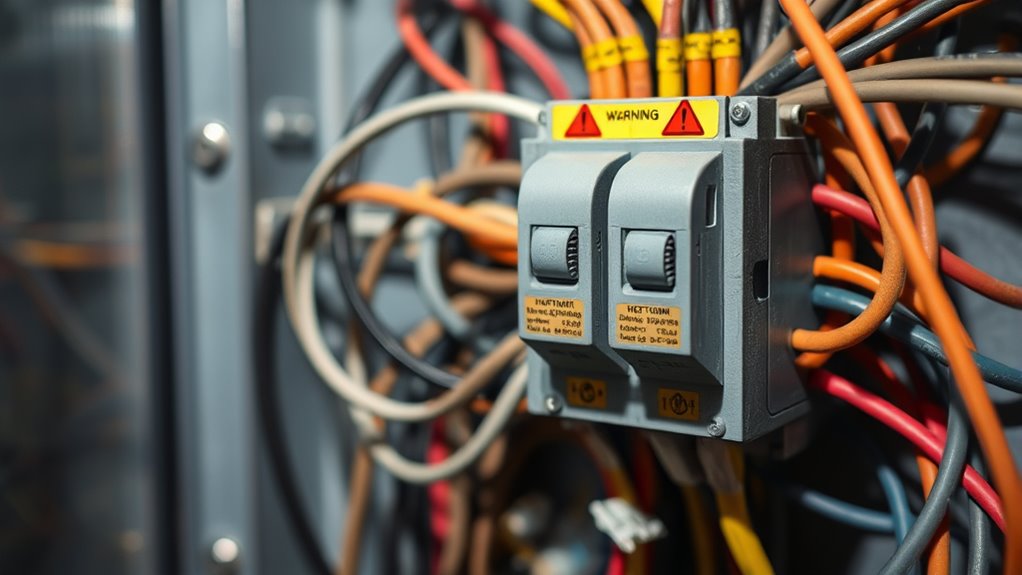
Detecting signs of backfeeding early can prevent serious hazards in your electrical system. Watch for unusual symptoms like frequent circuit overloads or repeated trips, which could indicate hidden issues. A ground fault may cause unexpected power flow, leading to dangerous backfeeding. Look for warm outlets or switches, especially near your main panel, as they can signal wiring problems. Use this table to identify common signs:
| Sign | What it indicates |
|---|---|
| Flickering lights | Possible backfeed or wiring issue |
| Unexpected power flow | Ground fault or backfeeding |
| Warm outlets or switches | Overloaded circuit or backfeed |
| Circuit trips frequently | Circuit overload or fault |
| Unusual buzzing sounds | Electrical malfunction |
Stay alert, and if you notice these signs, consult a professional immediately.
Safe Practices to Prevent Backfeeding Incidents
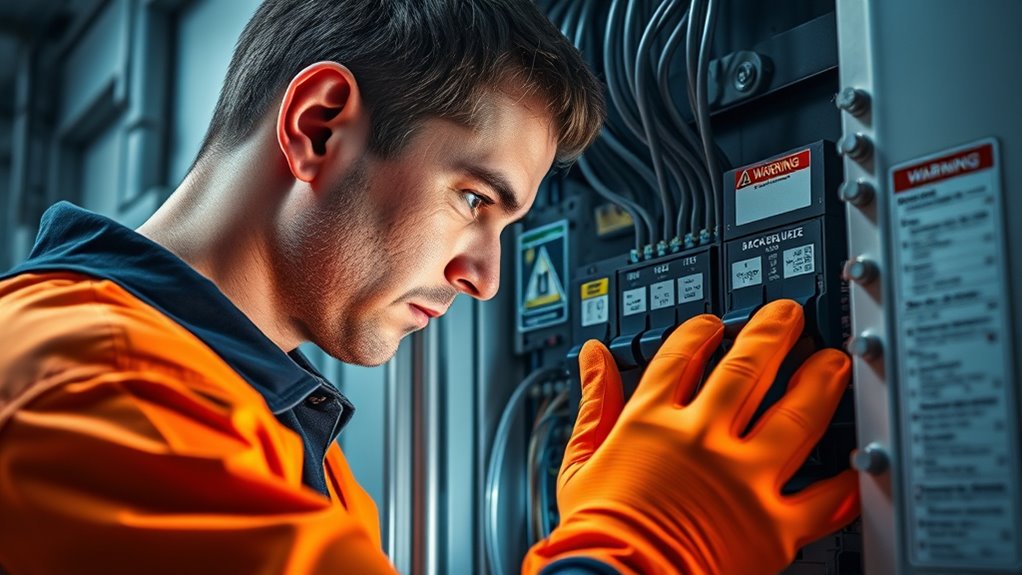
To minimize the risk of backfeeding incidents, adopting safe electrical practices is vital. Always make certain that your backup power systems are properly installed and maintained. Use dedicated transfer switches to connect backup generators to your main electrical system, preventing power from feeding back into the grid. Circuit isolation is essential; isolate circuits that could inadvertently energize other parts of your system during backup power operations. Never connect a generator directly to your home outlets without proper equipment, as this creates a backfeed hazard. Regularly inspect and test your backup power setup to confirm it functions correctly and safely. Proper system grounding ensures electrical safety and reduces the risk of backfeeding issues. These practices help prevent backfeeding incidents, protect utility workers, and guarantee your system remains safe during outages.
Quick Fixes and When to Call a Professional
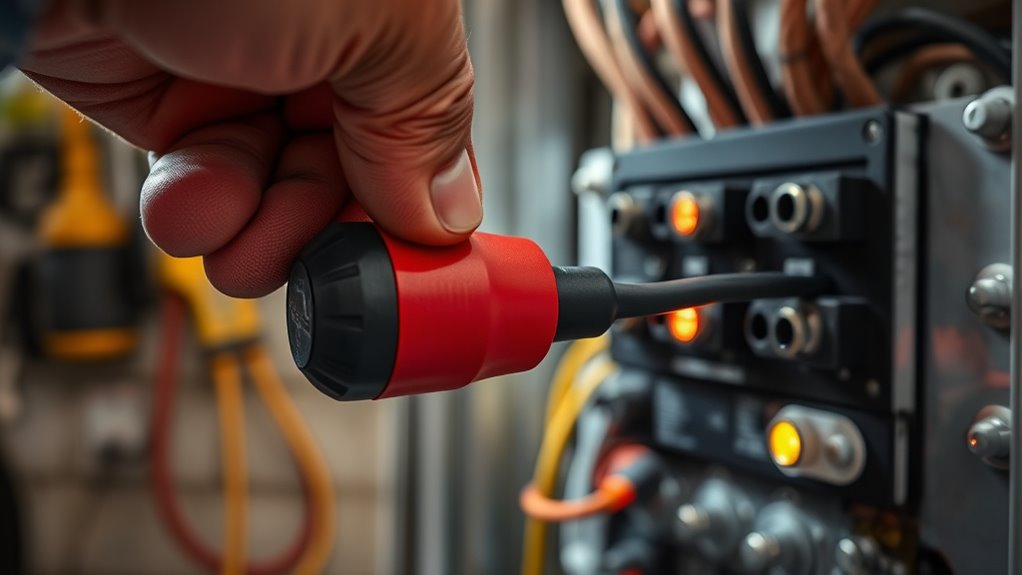
If you notice a quick fix might solve the issue, make sure you’re confident in your skills before attempting repairs. However, if the problem involves sparks, burning smells, or persistent electrical issues, it’s time to call a professional. Recognizing these serious signs can prevent dangerous backfeeding incidents and make certain of your safety. Additionally, understanding the importance of proper Gold IRA rollovers can help ensure your retirement investments remain secure during any financial adjustments.
When to Attempt Repairs
Knowing when to attempt a quick fix or call in a professional can save you time, money, and potential danger. If the issue involves a simple problem with the power source, like a loose connection or a blown fuse, you might handle it yourself, paying attention to repair timing. Confirm the power is completely shut off before working on any electrical component. However, if you’re unsure about the root cause or if the problem persists after a quick fix, it’s best to call a professional. Complex issues, such as damaged wiring or signs of electrical burning, require expert assessment to prevent hazards. Trust your judgment: when in doubt, prioritize safety and professional help. Proper repair timing and cautious assessment can help you avoid unnecessary risks.
Recognizing Serious Issues
Recognizing serious electrical issues is essential for your safety. If you notice frequent circuit trips or flickering lights, it could indicate circuit overloads that need professional attention. Grounding issues may cause shocks or sparks, especially around outlets or appliances. Pay attention to burning smells or sizzling sounds, which signal potential hazards. Never ignore exposed wiring or warm outlets; these are signs of serious problems. If your circuit breaker trips repeatedly, or if you see sparks or hear crackling, stop using the affected area immediately. These signs aren’t minor inconveniences—they’re warnings to call a licensed electrician. Addressing grounding issues and circuit overloads promptly can prevent electrical fires, shocks, or further damage to your system. Monitoring electricity usage can help identify patterns that might lead to hazards. When in doubt, it’s safer to consult a professional.
Frequently Asked Questions
Can Backfeeding Occur in All Types of Electrical Systems?
Backfeeding can occur in most electrical systems if proper generator safety and circuit protection aren’t in place. When you connect a generator incorrectly, it might feed power back into the grid or other circuits, risking damage or injury. Always make certain you use appropriate circuit protection devices and follow safety protocols. This helps prevent backfeeding, keeps your system safe, and avoids dangerous electrical hazards during generator use.
What Are the Legal Implications of Backfeeding Without Proper Authorization?
If you backfeed without proper authorization, you face serious legal liability for unauthorized connections. This can lead to fines, penalties, or even criminal charges, especially if it causes damage or safety hazards. Utility companies and regulatory agencies take unauthorized backfeeding very seriously because it poses risks to workers and the public. Always seek proper approval and follow safety protocols to avoid legal trouble and make certain everyone’s safety.
How Does Backfeeding Impact the Overall Electrical Grid Stability?
Oh, the irony of backfeeding! It might seem helpful, but it actually disrupts grid frequency and voltage regulation, risking widespread instability. When you backfeed without proper coordination, you interfere with the delicate balance that keeps the electrical grid functioning smoothly. This can cause fluctuations, outages, or even damage to equipment. So, while you might think you’re helping, you’re secretly challenging the grid’s stability and reliability.
Are There Specific Tools Recommended for Detecting Backfeeding Issues?
For detecting backfeeding issues, you should use tools like a multimeter and a clamp meter for effective circuit troubleshooting. These tools help you identify unexpected voltage or current flow, which is essential for maintaining solar safety. Always check your wiring connections thoroughly, especially when working with solar panels, to prevent dangerous backfeeding. Properly diagnosing these issues ensures your system operates safely, avoiding damage or hazards.
What Insurance Considerations Should Homeowners Be Aware of Regarding Backfeeding?
You should be aware that backfeeding can impact your insurance claims and liability coverage. If a backfeeding incident causes damage or injury, your insurer may scrutinize whether proper safety measures were in place. To protect yourself, verify your policy covers backfeeding-related risks and document safety procedures. Consulting with your insurer beforehand can help clarify coverage, so you’re not caught off guard if an incident occurs.
Conclusion
Now that you understand the risks of backfeeding, it’s essential to stay vigilant. One overlooked mistake could lead to serious injury or damage. Are you prepared to recognize the warning signs before it’s too late? Don’t leave safety to chance—take action now. The next incident could happen when you least expect it. Will you be ready to respond and protect yourself and your equipment? Stay alert—your safety depends on it.
